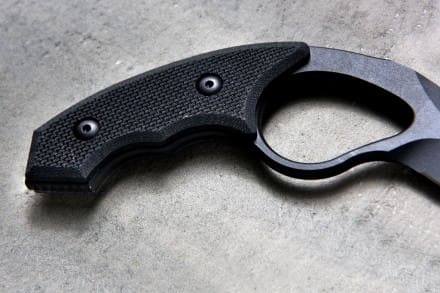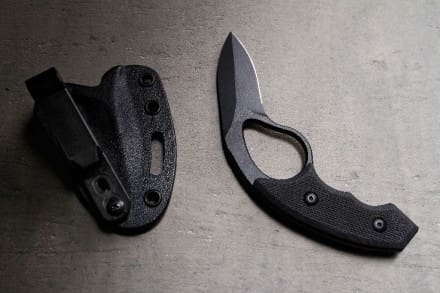This is pretty cool for all of you mounted guys.
To see it in action, check out the video below:
Original Footwear, manufacturers of Original S.W.A.T. and Altama boots, launched their factory store this morning.
They have a fully stocked retail location adjoining the factory at:
5968 Commerce Blvd.,
Morristown, TN 37814
In addition to quality Factory Seconds, they also offer New footwear at discounted prices.
Original Footwear runs an amazing factory in Morristown, and while it’s about an hour outside of Knoxville, the area is beautiful and not far from the Smoky Mountains. It’s definitely worth a stop, if you find yourself in the area.
Designed by Al and Nico Salvitti with AAR input from multiple Special Operations End Users, The Colonel is a fighting knife, through and through, working around the shooter and utilizing existing muscle memory to produce an effective stabbing and slashing weapon that requires no special training to maintain effectiveness.

The Colonel is designed to be drawn the same as a handgun, while striking with the blade is the same as throwing a punch. The grip angle, which mirrors that of a pistol, allows The Colonel to sit low in the hand for positive retention.

The shape of The Colonel’s blade makes it virtually impossible for a user to stab themselves while the blade is in use, something that can happen when fighters employ stabbing motions with other kinds of blades, and miss the target.

The Colonel Blade is hand forged in Italy with American made G10 grip panels; sharpening and assembly is completed in the US. Each blade is QPPed (Quench Polish Quench), a nitrocarburizing case hardening that increases corrosion and wear resistance. Simply put, The Colonel is designed to be durable and effective.
bravocompanymfg.com/thecolonel
The MMI Textiles Team has been growing in strength and numbers. We’re excited to announce a handful of new team members and a promotion.

Geoff Senko has been promoted to Regional Sales Manager. This promotion is a result of Geoff’s six years as a cornerstone of the MMI sales team. He has been a huge part of our success over the years and we are grateful to have him. He will continue servicing all his customers as he takes on the new role.
Additionally, we have hired 3 new team members over the past 3 months.
Andrew Joyce joined the management team in October. He joins as our new Global Business Manager. Andrew brings 25 years of sales and business experience from outside the industry to bring a fresh perspective and will help MMI continue its steady growth. He is a native Australian who married a Clevelander with a true love of his adopted city. We are excited to add him to our team!

Christine Campbell joined the team at the beginning of November as our Office Assistant. She is quickly making friends around the office as she offers to help with just about anything. Not to mention she loves Cleveland sports, so she fit in VERY quickly.
Last, but certainly not least, Lisa Lewis has been working with the team as our newest Customer Service Representative. She is quickly learning the ropes and helping in all the areas she can. We hope to officially bring her on to the team full-time at the end of the month!
As always, we are grateful to have a growing team. These changes are exciting and we couldn’t be happier. Onwards and upwards!
SureFire Field Notes is a multi-segment informational video series with tips and techniques from subject matter experts of all backgrounds. In this episode, Bill Murphy discusses the importance of having a tourniquet with you at all times.
Bill has been a police officer for over 37 years, currently working as a Reserve Deputy with Los Angeles County Sheriff Department. Bill was also a Senior Police Officer assigned to Patrol /SWAT with the Huntington Beach PD in California, where he was also a Firearms Instructor/Armorer, Use of Force Instructor, and a member of the Range Advisory Committee, Gunsite Training Center Rangemaster, a Police Academy Instructor, an NRA, FBI, and an Adjunct Instructor for the U.S. Air Force Pararescue Advanced Weapons School. Bill serves as Lead Instructor for low-light and firearms courses at the SureFire Institute.
This purchase is a pretty big deal as the Prox Dynamics PD-100 Black Hornet, Nano class UAV gains traction, including for such programs as the US Army’s Soldier Borne Sensor effort. You can see it here in this Army commercial.
WILSONVILLE, OR — (Marketwired) — 11/30/16 — FLIR Systems, Inc. (NASDAQ: FLIR) announced today that it has acquired Prox Dynamics AS, a leading developer and manufacturer of nano-class unmanned aerial systems (UAS) for military and para-military intelligence, surveillance, and reconnaissance applications, for approximately $134 million in cash.
Based in Oslo, Norway and founded in 2007 by pioneers in nano helicopter technologies, Prox Dynamics develops, manufactures, and distributes aerial sensors that are revolutionarily small, light, and covert surveillance systems. Prox Dynamics’ Personal Reconnaissance System (PRS) features their Black Hornet aerial sensor and a hand controller, a system that is pocket sized and hand-launched by a soldier in the field, enabling a significant advantage in situational awareness and mission planning. The Black Hornet aerial sensor utilizes FLIR’s Lepton micro thermal camera, visible spectrum cameras, advanced low-power rotor technology, and proprietary software for flight control, stabilization, and communications. The Black Hornet helicopter is one of the lightest, stealthiest, and safest drones in the market, offering a highly advanced, lifesaving surveillance solution for traditional military forces and special operations forces. Weighing less than one ounce, the Black Hornet helicopter can fly for up to 25 minutes at line-of-sight distances of up to one mile.
The addition of the Prox Dynamics business will augment FLIR’s Surveillance segment by extending FLIR’s Airborne sensor product line and fully leveraging Lepton technology. FLIR intends to invest in optimizing the PRS platform to further enhance the range, cost, flexibility, and performance of the system. The Prox Dynamics team will benefit from close interaction with FLIR’s thermal sensor development group as well as the ability to leverage FLIR’s brand, distribution, and customer support infrastructure to better serve a global base of users. The business will become FLIR’s Unmanned Aerial Systems (UAS) line of business operating within the Surveillance segment.
“This acquisition adds a unique unmanned aerial systems capability to our portfolio. The Prox Dynamics team has created a highly-differentiated solution, incorporating our Lepton sensor, for advanced intelligence, surveillance, and reconnaissance that fits well with our vision for growth for our Surveillance segment,” said Andy Teich, President and CEO of FLIR. “The team at Prox Dynamics operates with a commercial mindset, which is a great fit for FLIR’s ‘commercially developed, military qualified,’ or ‘CDMQ,’ operating philosophy. We are excited to welcome the Prox Dynamics team to FLIR and look forward to working together to further advance this remarkable system capability.”
FLIR anticipates the business and related transaction costs will be approximately $0.01 dilutive to its 2016 earnings per share.